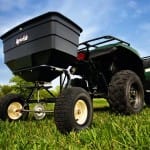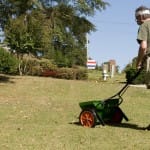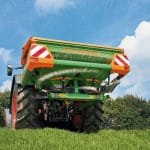Source(s): Gil Landry, PhD., Coordinator – UGA Center for Urban Agriculture, The University of Georgia.
Grass, like all other plants, requires nutrients for growth. Unfortunately, most soils in Georgia are naturally not rich in all these nutrients. Therefore, apply fertilizers to supply those elements not present in the native soil.
The three macronutrients are: nitrogen (N), phosphorus (P) and potassium (K). Of these, nitrogen is required in largest quantities, potassium second and phosphorus third. Most home lawn fertilizers sold in Georgia contain these three macronutrients in the largest amounts.
Fertilization programs should be based on turfgrass requirements, soil tests, maintenance practices, and desired appearance. For example, the bermudagrasses have a larger nitrogen requirement than most turfgrasses. A soil test is needed to determine the supply of phosphorus and potassium in the soil. When grass clippings are removed, the amount of fertilizer needed may be doubled. Increased irrigation on sandy soils will also increase fertilizer requirements. Finally, a higher quality, dark green lawn will require more nitrogen, as well as more clipping and watering.
Some considerations for determining what fertilizer material to use are ease of handling, price and availability. Since nitrogen is the key nutrient for lawn grasses, it is important to understand the differences in the nitrogen sources. There are three types of nitrogen carriers:
- synthetic inorganic,
- organic, and
- synthetic organic.
Synthetic Inorganic Nitrogen Carriers
Ammonium nitrate and ammonium sulfate are examples of synthetic inorganic nitrogen carriers. Some advantages are:
- rapid initial plant response,
- minimum temperature dependence, and
- lower cost per unit of nitrogen.
Disadvantages are:
- subject to loss by leaching in the nitrate form,
- high foliar burn potential, and
- a rapid surge in growth.
Natural Organic Nitrogen Carriers
This is nitrogen bound in complex organic compounds such as decayed living matter, sewage sludge, manures, and bone meal. Nitrogen released from these compounds is dependent upon microorganisms to break down organic matter. Advantages are:
- low foliar burn potential,
- longer lasting,
- very little leaching and
- more even growth of grass.
Some disadvantages are:
- low analysis, thus requiring a great deal of bulk,
- slow response and
at low temperatures, very little nitrogen is released through microorganisms activity.
Synthetic Organic Nitrogen Carriers
These nitrogen carriers are synthesized in the laboratory and can be divided into two groups:
- primarily water soluble compounds and
- primarily water insoluble compounds.
The water soluble compounds, such as urea, resemble the synthetic inorganic carriers in their activity, while the water insoluble compounds, such as urea formaldehyde, resemble the natural organic carriers in their activity.
Most mixed fertilizers contain more than one source of nitrogen. 12-4-8 is one example of a mixed fertilizer containing several different sources of nitrogen.
Guaranteed Analysis: 12-4-8
- Total Nitrogen(N) = 12%
- 6.50% Ammoniacal Nitrogen
- 1.00% Nitrate Nitrogen
- 0.90% Other Water Soluble Nitrogen
- 3.60% Water Insoluble Nitrogen
- Available Phosphate Acid(P205) = 4%
- Soluble Potash(K20) = 8%
- Total Available Plant Food, Not Less than = 24%
Fertilizer Programs
Applying fertilizer at the right time is as important as knowing what fertilizer to apply. Generally, spring and fall fertilization with a complete fertilizer (contains N, P and K) is recommended for the warm-season grasses. The spring application should be made about the time the grass begins to green-up and grow. The fall application should be made about 6 weeks before the average first frost date. Normally, the first frost date ranges from the latter part of October in the piedmont area to the end of November on the coast.
In the absence of soil test recommendations, the complete fertilizer used can range from 16-4-8 to 10-10-10 and 5-10-15, etc. Most of the warm-season grasses require 3 to 7 pounds of nitrogen per 1000 square feet per year to remain hardy and attractive. This fertilizer is usually applied in 3 to 5 applications during the growing season. A typical example would be 10 pounds of 12-4-8 per 1000 square feet in early spring when green-up begins, 10 more pounds in mid-summer, and 6-8 weeks before the average first frost date. This gives a total of 3.6 pounds of nitrogen.
Proper fertilization of centipedegrass is very important to its survival. Most people tend to over-fertilize centipede. One pound of nitrogen per 1000 square feet per year is ample nitrogen on most centipede lawns. On sandy soils in high rainfall areas, 2 pounds per 1000 square feet per year may be needed. Apply 5 pounds of 12-4-8 per 1000 square feet in early spring. If a second application is needed, apply 5 pounds of 12-4-8 per 1000 square feet in early August. Never apply lime to a centipede lawn unless soil tests show that the pH is extremely low. If the grass shows signs of iron chlorosis, which is observed by the yellowing of leaves, apply ferrous sulfate at the rate of one tablespoon per 3 gallons of water to each 1000 square feet of grass.
The cool-season grasses, such as tall fescue and Kentucky bluegrass, normally should receive the majority of their fertilizer requirements in the fall. An example of cool-season grass fertilization would be 10-15 pounds of 16-4-8 per 1000 square feet in early September and April. Additional nitrogen or complete fertilizer may be applied in November if desired.
Fertilizer Application
Listed below are some key points to remember when applying fertilizer.
- Don’t apply fertilizer when the grass leaves are wet. This can increase the potential of leaf burn.
- Use a mechanical spreader to distribute the fertilizer. Don’t apply it by hand. Use the two direction application procedure as described for seeding.
- If possible, water all fertilizer applications thoroughly.
Soil Acidity
Another important factor in plant growth is the soil acidity level. This is measured in terms of a pH scale which is graduated from 0 to 14 with 7 being neutral. Any number below 7.0 is considered acid with 5.0 being more acid than 6.0. Any number above 7.0 is considered basic with 9.0 being more basic than 8.0. Most turfgrasses, with the exception of centipedegrass and carpet grass, grow best at a pH of 6.0-6.5. Centipedegrass and carpet grass grow best at a pH of 4.5- 5.5. A pH either too low to too high will reduce the availability of plant nutrients. Therefore, it is very important that a proper pH be maintained.
Lime
If the soil becomes too acid, correct this by applying lime. Use a good agriculture grade of limestone. In most cases, a dolomitic source of limestone should be used. Base all lime applications on soil test results.
More detailed information concerning fertilization can be obtained in the Fertilization for Lawns, Bulletin No. 710.
Resource(s): Lawns in Georgia
Center Publication Number: 136
- Grasscycling: Feed Your Landscape, Not the Landfill - September 24, 2013
- Fertilizing Lawns - September 24, 2013
- Mowing Lawns - September 24, 2013


